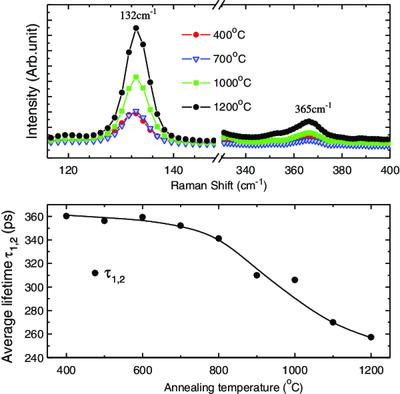当前位置:
X-MOL 学术
›
Phys. Status Solidi A
›
论文详情
Our official English website, www.x-mol.net, welcomes your
feedback! (Note: you will need to create a separate account there.)
Dependence of the Ferromagnetism on Vacancy Defect in Annealed In2O3 Nanocrystals: A Positron Annihilation Study
Physica Status Solidi (A) - Applications and Materials Science Pub Date : 2021-01-21 , DOI: 10.1002/pssa.202000631 Zihao Wang 1, 2 , Xiumei Dong 3 , Zhiyuan Chen 1, 2 , Houhua Xiong 1, 2 , Jie Gao 1, 2 , Jifu Du 1, 2 , Xiuqin Tang 1, 2 , Quankun Zhang 4 , Libing Qian 4 , Zhiquan Chen 4
Physica Status Solidi (A) - Applications and Materials Science Pub Date : 2021-01-21 , DOI: 10.1002/pssa.202000631 Zihao Wang 1, 2 , Xiumei Dong 3 , Zhiyuan Chen 1, 2 , Houhua Xiong 1, 2 , Jie Gao 1, 2 , Jifu Du 1, 2 , Xiuqin Tang 1, 2 , Quankun Zhang 4 , Libing Qian 4 , Zhiquan Chen 4
Affiliation

|
In2O3 nanoparticles are fabricated by a sol–gel method, and annealed under air atmosphere from 400 to 1200 °C. X‐ray diffraction patterns display that all samples are the cubic bixbyite structure, grain size remains nearly unchanged below 700 °C, but remarkable increases from 35 to 72 nm after annealing up to 1200 °C. Electron microscopy also confirms the grain growth during high‐temperature annealing, and the transmission electron microscopy characterizes good crystallinity inside the grains. Raman spectroscopy indicates that the crystallinity of annealed samples is improving and the concentration of oxygen vacancies is decreasing with the increase in annealing temperature. Positron annihilation lifetime measurements identify that there are a large number of monovacancies and vacancy clusters on the surface of nanoparticles. With the increase in annealing temperature, the monovacancies keep a slight recovery and their concentration increases, but the vacancy clusters become smaller vacancies and their concentration decreases. Room‐temperature ferromagnetism exists in the samples after annealing at 400–1000 °C, and the magnetization decreases gradually with the increase in annealing temperature, which is in coincidence with the recovery of vacancy clusters after annealing. These findings suggest that ferromagnetism in annealed In2O3 nanocrystals might be due to the indium–oxygen vacancy clusters rather than grain size effects.
中文翻译:

铁磁性对退火的In2O3纳米晶体中空位缺陷的依赖性:正电子An没研究
在2 O 3纳米粒子是通过溶胶-凝胶法制备的,并在400至1200°C的空气气氛中进行退火。X射线衍射图显示所有样品均为立方方铁矿结构,在700°C以下,晶粒尺寸几乎保持不变,但在退火至1200°C后从35 nm显着增加至72 nm。电子显微镜还确认了高温退火过程中晶粒的生长,而透射电子显微镜则表明了晶粒内部良好的结晶性。拉曼光谱表明,随着退火温度的升高,退火样品的结晶度提高,氧空位浓度降低。正电子an没寿命测量结果表明,纳米粒子表面上存在大量的单空位和空位簇。随着退火温度的升高,单空位保持轻微恢复并且其浓度增加,但是空位簇变得更小空位并且其浓度降低。在400–1000°C退火后,样品中存在室温铁磁性,并且随着退火温度的升高,磁化强度逐渐降低,这与退火后空位团簇的恢复是一致的。这些发现表明,退火后的铁磁性 随着退火温度的升高,磁化强度逐渐降低,这与退火后空位团簇的恢复相吻合。这些发现表明,退火后的铁磁性 随着退火温度的升高,磁化强度逐渐降低,这与退火后空位团簇的恢复相吻合。这些发现表明,退火后的铁磁性2 O 3纳米晶体可能是由于铟-氧空位簇而不是晶粒尺寸的影响。
更新日期:2021-03-17
中文翻译:

铁磁性对退火的In2O3纳米晶体中空位缺陷的依赖性:正电子An没研究
在2 O 3纳米粒子是通过溶胶-凝胶法制备的,并在400至1200°C的空气气氛中进行退火。X射线衍射图显示所有样品均为立方方铁矿结构,在700°C以下,晶粒尺寸几乎保持不变,但在退火至1200°C后从35 nm显着增加至72 nm。电子显微镜还确认了高温退火过程中晶粒的生长,而透射电子显微镜则表明了晶粒内部良好的结晶性。拉曼光谱表明,随着退火温度的升高,退火样品的结晶度提高,氧空位浓度降低。正电子an没寿命测量结果表明,纳米粒子表面上存在大量的单空位和空位簇。随着退火温度的升高,单空位保持轻微恢复并且其浓度增加,但是空位簇变得更小空位并且其浓度降低。在400–1000°C退火后,样品中存在室温铁磁性,并且随着退火温度的升高,磁化强度逐渐降低,这与退火后空位团簇的恢复是一致的。这些发现表明,退火后的铁磁性 随着退火温度的升高,磁化强度逐渐降低,这与退火后空位团簇的恢复相吻合。这些发现表明,退火后的铁磁性 随着退火温度的升高,磁化强度逐渐降低,这与退火后空位团簇的恢复相吻合。这些发现表明,退火后的铁磁性2 O 3纳米晶体可能是由于铟-氧空位簇而不是晶粒尺寸的影响。











































 京公网安备 11010802027423号
京公网安备 11010802027423号